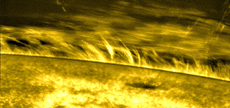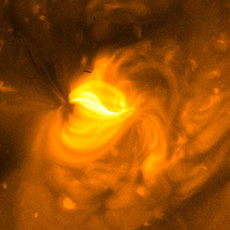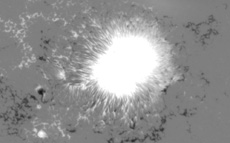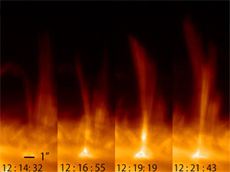
Q. Could you describe HINODE's major achievements so far?
HINODE is the world's most advanced orbital solar observatory. It was developed by JAXA (the Japan Aerospace Exploration Agency) with the National Astronomical Observatory of Japan (NAOJ) as domestic partner and research institutes in the United States (NASA) and the United Kingdom (STFC) as international partners. The mission is operated by these agencies in corporation with the European Space Agency (ESA) and Norwegian Space Center, who support data downlinks at Svalbard station. We also accept observation proposals from researchers over the world and the data are open to any researchers for data analysis as soon as they are acquired by HINODE.


Cold plasma floating in the corona above the solar limb. Alfvén waves were observed for the first time, extrapolated from fluctuations of the plasma.
The corona is the outer atmosphere of the Sun, about 2,000 kilometers above the Sun's surface. It consists of gas at over one million degrees Celsius, compared to the temperature of the solar surface, which is about 6000ºC. Why is the Sun's corona so hot? This is the ultimate mystery of the Sun. Solar energy travels from the Sun's interior to its surface, so, theoretically, the temperature should decline as it moves outward. In reality, however, the reverse occurs. The temperature increases dramatically - as much as one hundred times - as it travels away from the solar surface to the Sun's corona. This phenomenon has not yet been explained. But the theory is that energy created by turbulent, convective motions on the solar surface is transmitted along magnetic field lines to the corona, where the gas is heated by dissipating the energy. There are two major hypotheses about the details of this physical process. One holds that the Sun's atmosphere is heated by small eruptions on its surface. Many explosions called nanoflares (much smaller than the massive explosions known as flares) are occurring on the surface and are the source of energy for coronal heating. The other hypothesis proposes that convective motions on the solar surface cause magnetic field lines to fluctuate, generating waves along them. These waves eventually reach the corona, and provide the energy that heats it.
HINODE has provided the first detection of such a wave along magnetic field lines. In this image, the limb of the Sun is at the center, and above it, there are many structures stretching out horizontally, called threads. These are pockets of cooler gas floating along magnetic field lines in the corona. When we analyzed their motion, we found that these pockets fluctuated up and down. We interpreted that these phenomena are a manifestation of Alfvén waves: vibrations that are generated along magnetic field lines. Using cooler gas floating in the corona, we identified the dynamics of invisible magnetic field lines. The Solar Optical Telescope (SOT) aboard HINODE was able to observe these waves for the first time. They had gone undetected because their amplitude is so small.
The discovery of Alfvén waves in the solar atmosphere is a remarkable step in our understanding of the coronal heating. But we still aren't ready to fully explain coronal heating and need more observations.

The Sun constantly ejects plasma into interplanetary space - a phenomenon called solar wind. These huge plasma clouds are released when massive explosions, known as flares, occur on the solar surface, although plasma outflow also occurs without flaring. Solar wind disturbs Earth's magnetic field, sometimes causing problems such as the malfunctioning of electronic equipments on spacecraft orbiting the planet. Because solar wind affects our planet, it is critical to understand its origin.
For the first time in history, HINODE successfully captured solar-wind outflows on X-ray movies. High-speed solar wind, moving at up to 900 kilometers per second, has been known to emanate from polar coronal holes, which are regions of low coronal density. However, the origins of low-speed solar wind (400 to 600 kilometers per second) had never been detected. The X-Ray Telescope (XRT) on HINODE has now discovered a new source of low-speed solar wind. Coronal gas was observed to flow up along magnetic field lines at the boundary between a coronal hole and an active region, with many sunspots and strong magnetic fields, which are located at low latitudes. Unlike most solar magnetic field lines that return to the solar surface, we found that the magnetic field lines with gas outflows expand into interplanetary space. That is, coronal gas, emanating along magnetic field lines into space, is filling our solar system.
The ultimate question about solar wind is "what is its velocity mechanism?" In other words, where and how does solar wind accelerate on its way to Earth? The velocity measured near the solar surface in HINODE's X-ray observation was 140 kilometers per second. However, in general, when approaching Earth, the speed increases, at its fastest, to about 900 kilometers per second, and, on average, to 500 or 600 kilometers per second. Understanding the velocity mechanism of solar wind is an important research task.

Corona above a solar active region. The dark spot on the top left is a plasma flow emanating outward.

Before HINODE, it was extremely difficult to observe the dynamic motions of magnetic field lines on the solar surface. The unprecedented resolution of HINODE's Solar Optical Telescope is around 0.2 arcseconds, which can analyze a magnetic field structure of 100 to 200 kilometers on the Sun's surface. Magnetic field lines on the solar surface are quantized as magnetic flux tubes at about 0.2 arcsecond, which have kilo gauss order of magnetic field strength. HINODE has captured video images of the formation of magnetic flux tubes, as well as dynamical evolutions of these tubes in continuous turbulent convection on the solar surface. And, while researchers had assumed that most magnetic field lines existed as magnetic flux tubes, HINODE has revealed that magnetic field lines that lie almost parallel to the solar surface outnumber magnetic field lines in magnetic flux tubes. They float and sink in accordance with the convection on the Sun's surface. We have also discovered that, in regions where magnetic field lines are moving dynamically, gas on the surface is jetting at near sonic velocity or greater.
Another new discovery was the observation of continuous microjets and plasma eruptions in the chromosphere, which is just above the photosphere, into the upper atmosphere. HINODE has recorded video that captures the vicinity of the limb of the Sun, using a filter to catch the light of chromospheric plasma, and producing a brilliant visual of chromospheric plasma jetting up towards the corona along invisible magnetic lines. Scientists will now be able to investigate the physical process of the interaction between the dynamic magnetic field lines and the gas.

Line-of-sight magnetogram of a sunspot and its surroundings. Black and white represent negative and positive polarity respectively.

Microjet in the chromosphere